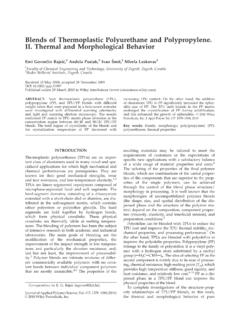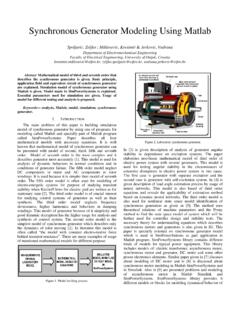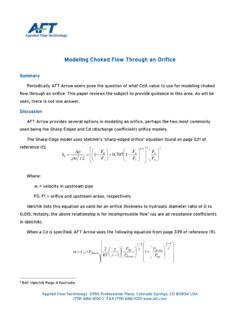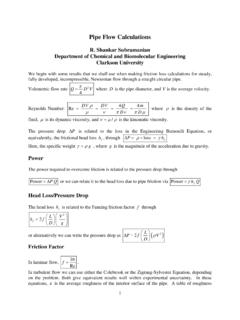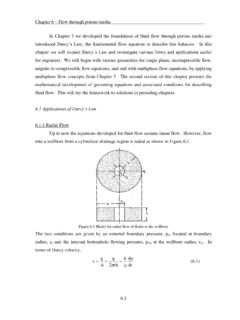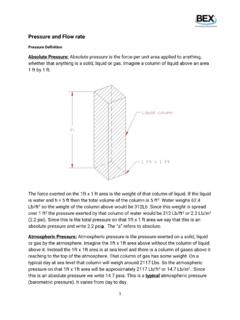Transcription of Natural gas properties and flow computation
1 Natural gas properties and flow computation501 Natural gas properties and flow computationIvan Mari and Ivan IvekX Natural gas properties and flow computation Ivan Mari and Ivan Ivek Ru er Bo kovi Institute Croatia 1. Introduction Precise measurement of fluid flow rate is essential in commercial and in process control applications. The flow rate can be measured using different principles and devices (Baker, 2000, Miller, 1996): Orifice, Turbine, Venturi, Nozzle, Target, V-cone, Pitot, Multiport averaging, Elbow, Wedge, Laminar flow, Gilfo, Positive displacement, Thermal mass, Ultrasonic-time of flight, Variable area, Vortex, Coriolis. The measurement accuracy varies from 5% of rate (Pitot) down to of rate (Coriolis). The Coriolis mass flowmeters are generally used to measure the mass flow of liquids but have been also used for the measurement of flow of high density gases. The turbine meters are widely used for the measurement of the volumetric flow rate of clean gases ( of rate) and liquids ( 1% of rate).
2 The flow rate measurements based on orifice meters are less accurate (1-2% URV) but the orifice plates are the most widely used devices in Natural gas flow rate measurements due to their simplicity and robustness. We will here illustrate the thermodynamic effects that may cause significant error in measurements of Natural gas flow rate based on orifice meters. We will also demonstrate how they could be efficiently compensated. In measurements based on orifice plates the temperature of the fluid measured upstream of the orifice plate is used for the calculation of the flow rate but the fluid temperature is preferably measured downstream of the orifice plate (ISO-5167-1, 2003). When a gas is forced to flow through an orifice its temperature is changed due to the Joule-Thomson (JT) effect. The effect can be generally neglected for low flow rates for low differential pressures measured across the orifice meter (ISO-5167-1, 2003).
3 At higher differential pressures and at lower temperatures the flow rate error increases and generally needs to be compensated (Mari , 2007). The precise compensation of flow rate error implies double calculation of Natural gas properties and the flow rate, which extends the calculation time significantly and may become impractical for implementation in low-computing-power embedded systems. To avoid the computational burden the original high complexity models of Natural gas properties can be replaced by the corresponding low-complexity surrogate models (Mari & Ivek, IEEE, Mari & Ivek, 2010) with no significant deterioration of flow rate accuracy. Comprehensive presentation of modern methods of estimating the physical properties of gases and liquids can be found in (Poling at al., 2000). Formulations explicit in the Helmholtz energy have been widely used to represent the properties of Natural gas because of the ease of calculating all other thermodynamic properties by mathematical 21 Natural Gas502 differentiation (Lemmon & Starling, 2003, Span & Wagner, 1996, Span & Wagner, 2003).
4 The Helmholtz energy is a fundamental thermodynamic property from which all other thermodynamic properties can be calculated as derivatives with respect to molar density or temperature. The detailed procedure for the calculation of thermodynamic properties based on formulations explicit in Helmholtz energy (Lemmon & Starling, 2003) and on AGA-8 detail characterization equation (Starling & Savidge, 1992) is given in (ISO-207651-1, 2005). Here we will elaborate an alternative procedure for the calculation of properties of a Natural gas that was originally published in the Journal Flow Measurement and Instrumentation (Mari , 2005 & 2007). The procedure is derived using fundamental thermodynamic equations (Olander, 2007), DIPPR AIChE (DIPPR Project 801, 2005) generic ideal heat capacity equations, and AGA-8 (Starling & Savidge, 1992) extended virial-type equations of state. The procedure specifies the calculation of specific heat capacities at a constant pressure cp and at a constant volume cv, the JT coefficient JT, and the isentropic exponent of a Natural gas.
5 The effect of a JT expansion on the accuracy of Natural gas flow rate measurements will be pointed out. The possibilities of using the computational intelligence methods - Artificial Neural Networks - ANNs (Ferrari & Stengel, 2005, Wilamowski et al., 2008) and machine learning tools - Group Method of Data Handling - GMDH (Ivakhnenko, 1971, Nikolaev & Iba, 2003) for meta-modeling the effects of Natural gas properties in flow rate measurements (Mari & Ivek, 2010) will be illustrated. The practical examples of ANN and GMDH surrogate models for the compensation of Natural gas flow rate measurement error caused by the thermodynamic effects, with the corresponding accuracies and execution times will be given. The models are particularly suitable for implementation in low computing power embedded systems. 2. A procedure for the calculation of thermodynamic properties of Natural gas This section summarizes the procedure (Maric, 2007) for the calculation of specific heat capacity at constant pressure cp and at constant volume cv, JT coefficient JT and isentropic exponent of a Natural gas based on thermodynamic equations, AGA-8 extended virial type characterization equation (Starling & Savidge, 1992, ISO-12213-2, 2006) and DIPPR generic ideal heat capacity equations (DIPPR Project 801, 2005).
6 First, the relation of the molar heat capacity at constant volume to equation of state will be derived. Then the relation will be used to calculate a molar heat capacity at constant pressure, which will be then used for the calculation of the JT coefficient and the isentropic exponent. The total differential for entropy (Olander, 2007), related to temperature and molar volume, is: mTmvdvvsdTTsdsm , (1) where s denotes entropy, T denotes temperature and mv is a molar volume of a gas. By dividing the fundamental differential for internal energy mdvpdsTdu by dT while holding mv constant the coefficient of dT in Eq. (1) becomes Tcvm/, since the molar heat at constant volume is defined by mvvmTuc ,. The Maxwell relation mvTmTpvs , is used to substitute the coefficient of mdv. Finally, the Eq. (1) becomes: mvvmdvTpdTTcdsm ,. (2) Similarly, starting from a total differential for entropy related to temperature and pressure (Olander, 2007) dppsdTTsdsTp and by dividing the fundamental differential for enthalpy dpvdsTdhm by dT while holding p constant, the coefficient of dT in total differential becomes Tcpm/, since the molar heat capacity at constant pressure is defined by: ppmThc.
7 The Maxwell relation pmTTvps is used to substitute the coefficient of dp and the following relation is obtained: dpTvdTTcdspmpm ,, (3) Subtracting Eq. (2) from Eq. (3), then dividing the resulting equation by mdv while holding p constant and finally inverting the partial derivative pmvT the following equation is obtained: mvpmvmpmTpTvTcc ,,. (4) A total differential of thermodynamic property, Eqs. (2) and (3), must be the exact differential the order of forming the mixed second derivative is irrelevant. The partial derivative of the first coefficient with respect to the second variable equals to the partial derivative of the second coefficient with respect to the first variable. By applying this property to Eq. (2) and by assuming T to be the first variable with the corresponding coefficient Tcvm,and mv the second variable with the corresponding coefficient mvTp we obtain: mvTmvmTpTvc 22,, (5) The Eq.
8 (5) can be rewritten in the following integral form: Natural gas properties and flow computation503 differentiation (Lemmon & Starling, 2003, Span & Wagner, 1996, Span & Wagner, 2003). The Helmholtz energy is a fundamental thermodynamic property from which all other thermodynamic properties can be calculated as derivatives with respect to molar density or temperature. The detailed procedure for the calculation of thermodynamic properties based on formulations explicit in Helmholtz energy (Lemmon & Starling, 2003) and on AGA-8 detail characterization equation (Starling & Savidge, 1992) is given in (ISO-207651-1, 2005). Here we will elaborate an alternative procedure for the calculation of properties of a Natural gas that was originally published in the Journal Flow Measurement and Instrumentation (Mari , 2005 & 2007). The procedure is derived using fundamental thermodynamic equations (Olander, 2007), DIPPR AIChE (DIPPR Project 801, 2005) generic ideal heat capacity equations, and AGA-8 (Starling & Savidge, 1992) extended virial-type equations of state.
9 The procedure specifies the calculation of specific heat capacities at a constant pressure cp and at a constant volume cv, the JT coefficient JT, and the isentropic exponent of a Natural gas. The effect of a JT expansion on the accuracy of Natural gas flow rate measurements will be pointed out. The possibilities of using the computational intelligence methods - Artificial Neural Networks - ANNs (Ferrari & Stengel, 2005, Wilamowski et al., 2008) and machine learning tools - Group Method of Data Handling - GMDH (Ivakhnenko, 1971, Nikolaev & Iba, 2003) for meta-modeling the effects of Natural gas properties in flow rate measurements (Mari & Ivek, 2010) will be illustrated. The practical examples of ANN and GMDH surrogate models for the compensation of Natural gas flow rate measurement error caused by the thermodynamic effects, with the corresponding accuracies and execution times will be given.
10 The models are particularly suitable for implementation in low computing power embedded systems. 2. A procedure for the calculation of thermodynamic properties of Natural gas This section summarizes the procedure (Maric, 2007) for the calculation of specific heat capacity at constant pressure cp and at constant volume cv, JT coefficient JT and isentropic exponent of a Natural gas based on thermodynamic equations, AGA-8 extended virial type characterization equation (Starling & Savidge, 1992, ISO-12213-2, 2006) and DIPPR generic ideal heat capacity equations (DIPPR Project 801, 2005). First, the relation of the molar heat capacity at constant volume to equation of state will be derived. Then the relation will be used to calculate a molar heat capacity at constant pressure, which will be then used for the calculation of the JT coefficient and the isentropic exponent. The total differential for entropy (Olander, 2007), related to temperature and molar volume, is: mTmvdvvsdTTsdsm , (1) where s denotes entropy, T denotes temperature and mv is a molar volume of a gas.



